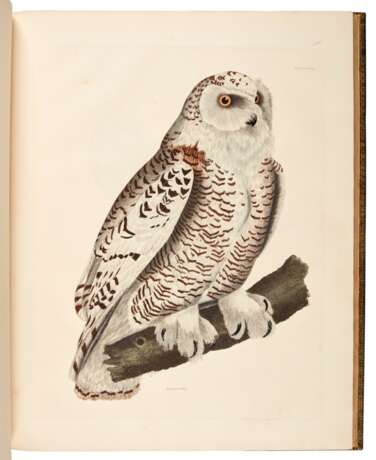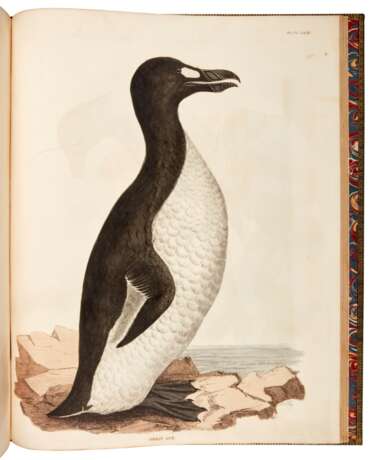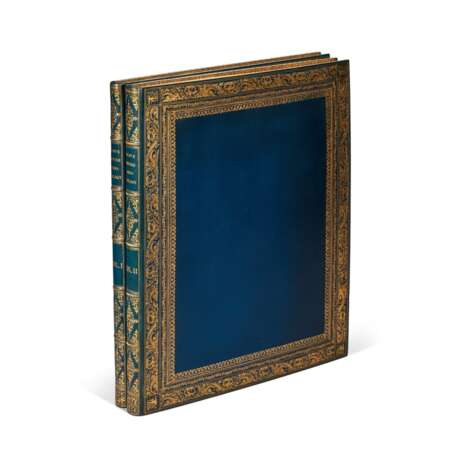Prideaux John Selby | Illustrations of British ornithology. Edinburgh and London, 1821–1834, 2 volumes, life size ornithological plates by the British Audubon
28.11.2023 14:00UTC +00:00
Classic
Vendu
21590GBP £ 21 590
| Auctioneer | Sotheby´s |
|---|---|
| Lieu de l'événement | Royaume-Uni, London |
Archive
La vente aux enchères est terminée. Vous ne pouvez plus enchérir.

ID 1076600
Lot 77 | Prideaux John Selby | Illustrations of British ornithology. Edinburgh and London, 1821–1834, 2 volumes, life size ornithological plates by the British Audubon
Valeur estimée
£ 20 000 – 30 000
Illustrations of British ornithology. Edinburgh and London: W. H. Lizars; Longman, Rees, Orme, Brown, Green, & Longman; W. Curry Jun. & Co., [1821]–1834 (watermarks 1815–1833)
FIRST EDITION, 2 volumes bound from the original parts, folio (660 x 520mm. without octavo text volumes), with engraved titles by W.H. Lizars and 218 FINE HAND-COLOURED ETCHED PLATES, many heightened with gum arabic, three folding at foot, by Selby or Robert Mitford after drawings by Selby, Mitford, or William Jardine, engraved by W. H. Lizars, coloured by Daniel McNee and others, 4 etched plates of anatomical details by and after Selby, later blue morocco gilt in period style, marbled endpapers, gilt edges, titles with a bit of foxing and expert repair to a clean vertical cut running the length of the page, occasional minor foxing, small marginal stains, or faint offsetting onto blank facing pages, plate XI in volume 2 with a small tear at tail of gutter, affecting a one-inch (background) section of the image
Described by Mullens & Swann as the “English equivalent of Audubon’s famous work,” reaching that status because of its “magnificent life-size plates”. Contemporary ornithologist William Swainson described it as “the most splendid and costly work yet published on the birds of Great Britain.”
Prideaux John Selby (1788-1867) was fascinated by birds from childhood. ODNB notes that he began to make “careful, coloured drawings of the birds in his district” while still a Durham schoolboy, supplementing his images with notes on the birds’ habits and characteristics. He began issuing the plates for British Ornithology in 1821, etching the images from his own drawings with the help of his brother-in-law, Robert Mitford, who had trained with Thomas Bewick. The plates were finished by the engravers at W. H. Lizars (Audubon’s publisher) and coloured by a team headed by artist Daniel McNee, later president of the Royal Scottish Academy. The Lizars firm did a number of books with illustrations from both steel and copper plates, but, as Jackson observes, “never surpassed the work done for Illustrations of British Ornithology’”. The plates were issued in parts over 13 years, while the text volumes were issued separately in 1833, in order to secure copyright without providing the copyright libraries with the costly plates; consequently, volumes with plates from the original parts are usually found without the text, as here (a re-issue by Henry Bohn in 1841 combined the text and plates, and is the version more commonly seen in the marketplace).
Selby’s illustrations have an austere elegance and clarity that set them apart from the other great works of British ornithology. According to Jackson, “Selby’s bird figures were the most accurate delineations of British birds to that date, and the liveliest. After so many books with small, stiff bird portraits, this new atlas with its life-size figures and more relaxed drawing was a great achievement in the long history of bird illustration”.
Sets like the present one, with all watermarks before 1840, are rare; the popularity of the work led Lizars to re-issue the illustrations several times, with the result that sets are frequently composed of a mix of early and later plates.
| Catégorie maison de vente aux enchères: | Impressions, graphiques, livres |
|---|
| Catégorie maison de vente aux enchères: | Impressions, graphiques, livres |
|---|
| Adresse de l'enchère |
Sotheby´s 34-35 New Bond Street W1A 2AA London Royaume-Uni | |
|---|---|---|
| Aperçu |
| |
| Téléphone | +44 (0) 20 7293 5000 | |
| Téléphone | +1 212 606 7000 | |
| Conditions d'utilisation | Conditions d'utilisation |






